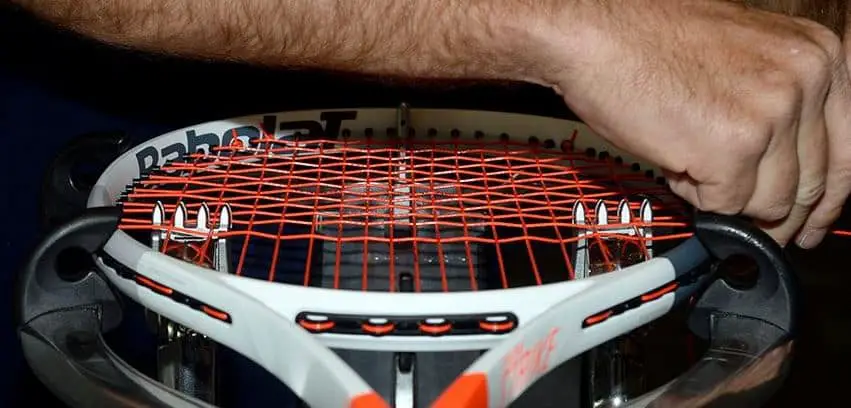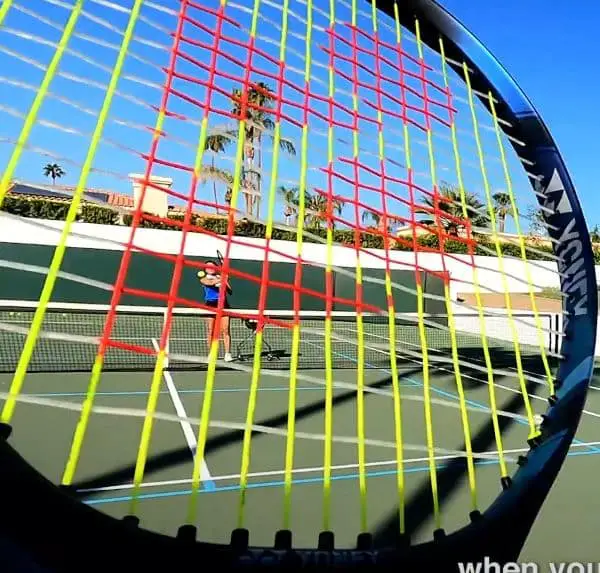
What Tension Should You String Your Tennis Racquet With? [Easy Guide]
You always see tennis players discussing what tension to use and what are the pros using in their game.
In this guide, we will explain in easy steps how racquet tension works and what you should use depending on your personal playing conditions.
What Is Racquet Tension?
First, it’s important to know that string tension is the weight that is applied to each string of the racquet. To string a racquet, let’s say, at 50 lbs is as if every string is holding 50 lbs attached to it. The weight applies a traction force called tension (T).

The tension of the racquet has a big influence on how you feel the racquet and how you strike every ball. Most players like to string their racquets at 48 to 55 lbs.
However, there are some exceptions, like French Adrian Mannarino, who likes to use a low tension of 24 lbs.
How to Choose Your Racquet Tension?
The tension that you should put on your racquet strings depends on several factors:
- your level,
- your playing style,
- your racquet,
- the string you are using
- your personal preferences.

If you have absolutely no idea how much tension to put in, use this easy rule of thumb:
- Find the recommended tension imprinted somewhere in your racquet, or online for your model. It should be something like [51, 59 lbs].
- String your racquet at the median recommended tension, in this case, 55 lbs. Use it as a starting point.
- After several hits, adjust the tension based on the feel and the sensations the racquet gave you.
- If you feel you lack control, bump it up a little. On the other hand, if you feel you lack power, lower it.
- Keep adjusting progressively until you find your tension’s sweet spot. It might take some time to find the best tension for your game, but it’s worth it.
How Does Racquet Tension Affect Your Tennis Game?
Increasing your racquet tension gives you:
- More control, the ball doesn’t travel that much
- Less power
- Less spin
- Less durability, the strings generally break earlier
- Less comfort, as the string becomes stiff and the energy transfer to your arm higher
Decreasing your racquet tension gives you:
- Less control, the ball starts to fly out of the court too often
- More power, as the string bed returns a big amount of kinetic energy
- More spin
- More comfort, as your body isn’t engaged much in generating power
- More durability
Consider the Racquet Head Size for the Choice of Tension
Yes, the racquet head size is a big factor to consider when you want to choose the strings and the tension.
A big head size (generally above 100 sq. in) signifies that the frame is high-powered. So you might want to increase the tension in these kinds of frames to get more control.
Similarly, you can decrease the tension on a smaller-head racquet (95 and under) to get more power as the frame already offers control.
Consider the Racquet String Pattern for the Choice of Tension
There are many types of string patterns in tennis racquets. Here is how to adjust your tension for the most famous patterns.
- Tight string bed: Like 18×20 or 18×19. The strings are close to each other, so you should lower the tension to create power and spin.
- Loose string bed: Like 16×19 or 16×18. The strings are spaced out, which already creates snapback and power. So consider increasing the tension to get more control and precision.
Different Tension in the Mains and the Crosses
Many professional players use a different tension in the mains and the crosses of their string bed.
The reason is that they use a hybrid setup, which is putting two different string types vertically and horizontally.

And, when a string is softer than the other, the tension must be increased by a pound or two to match the stiffness of the other string.
Most club players use a uniform bed consisting of the same poly string. Thus they generally don’t bother much about different tensions.
Nevertheless, the only time you might consider it is when you use a poly + natural gut setup, as players like Federer, Djokovic, or Serena do.
Consider String Type for Choice of Tension
It is important to note that the type of string used can affect the recommended tension range.

For example:
- Polyester strings are stiffer and less elastic than natural gut or synthetic gut strings, which means they can be strung at a higher tension without losing too much power.
- Natural gut or synthetic gut strings are more elastic and provide more power, which means they may require a lower tension to achieve the desired level of control.
It is always best to check with a professional tennis stringer or just your club stringer who can help you determine the best string and tension for your individual needs like your level, arm strength, playing surface…









